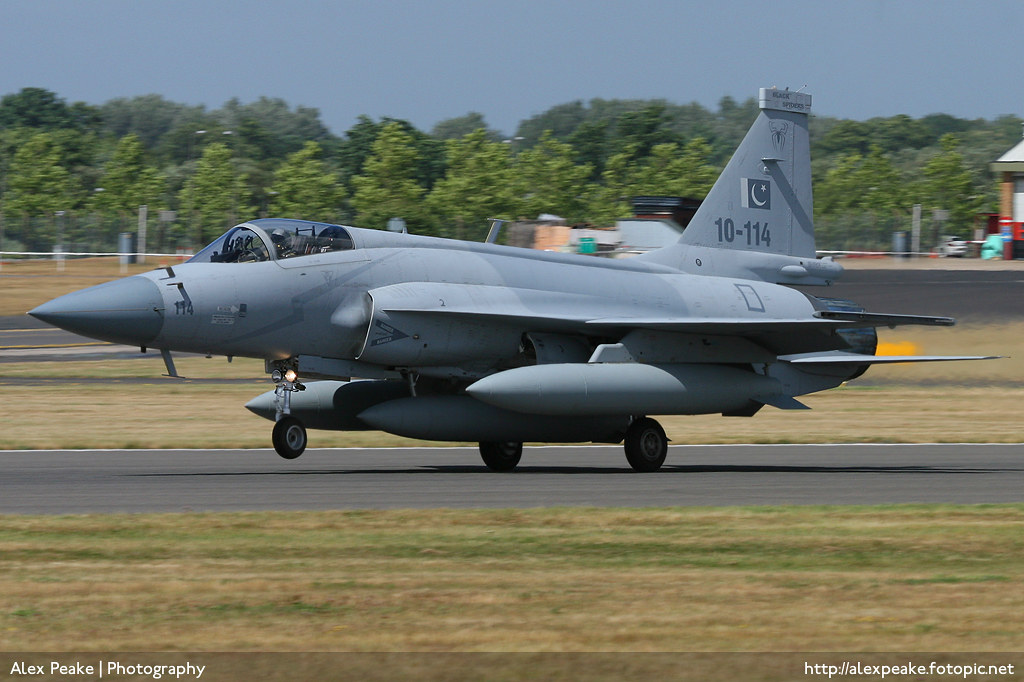China Pitches Engine Deal to Russia - Defense News
By TOM KINGTON Published: 26 July 2010
FARNBOROUGH, England - Chinese aerospace officials have grown so confident of their manufacturing ability that they have offered to help Russia boost the power of its fighter jet engines to increase sales.
Discussing the Russian-built RD-93 engine at the Farnborough Air Show, Ma Zhiping, president of the China National Aero-Technology Import and Export Corp. (CATIC), said Chinese know-how could help add some needed thrust.
"I hope to get to 9,000 kilograms with our help," he said. "If we can do that, we will help sales."
Ma was speaking as two Chinese-designed JF-17s made their first-ever appearance at the air show here. Flown by the Pakistan Air Force and built with the help of Pakistani industry, the jet is powered by the RD-93 engine, sold to China by Russia's Chernyshyov Machine-building Enterprise.
The arrival of the JF-17 jets was enough to set tongues wagging about China's increasingly assertive profile as a fighter builder. But Ma's desire to improve on Russian technology reflects China's aspirations to global power status.
His views were even more notable as they came in the wake of demands by Sukhoi and MiG chief Mikhail Pogosyan to block sales of 100 RD-93 engines to China as exports of the JF-17 could hamper Russia's attempts to export its own fighters. China has built the $20 million JF-17 as an export-only jet.
Pogosyan also suggested last week that a new fighter China has just test-flown is no more than a copy of the Sukhoi Su-33.
His request to block engine exports to China was, however, given short shrift here by Alexander Mikheyev, deputy head of Russian defense export agency Rosobo-ronexport, who said Russian jets have nothing to fear.
"Rosoboronexport continues implementing the contract for the delivery of RD-93 engines to China," he said. "The tactical-technical characteristics of Chinese aircraft are far behind those of Russian MiG and Sukhoi aircraft."
Turning to China's sale of Russian-powered JF-17s to Pakistan, Mikheyev added, "deliveries of Chinese fighter jets to Pakistan are not creating competition for Russia because Russia does not supply weapons to that country."
Shrugging off Mikheyev's views of Chinese fighters, Ma is undertaking an aggressive JF-17 export campaign and ordering engines from Moscow accordingly. After purchasing 100 engines five years ago, China wants to sign for another 100 by the end of the year or soon after - the order that Pogosyan objected to.
"The first 100 bought were to supply the Pakistan order or other countries from a list of six or seven African and Asian nations, which we supplied to Russia," Ma said.
"Last week, CATIC officials went to Moscow to discuss the second order of 100, and there were no problems with the same list of export targets applying. Now we are discussing expanding that list."
Should sales of the JF-17 prompt Moscow to reconsider its verdict of Chinese fighters and block RD-93 sales, China is meanwhile planning its own reportedly more powerful replacement engine, the WS-13.
But Ma said he prefers to stick with the Russian engine, if it remains available. "I think the RD-93 is a one-off option for the JF-17, but if they stop, we must rethink," he said.
Asked if he would seek Russian collaboration on the WS-13, Ma said, "we had discussions, but I prefer to work with them on the RD-93, taking on overhaul capabilities, and I hope to go to 9,000 kilograms with our help."
At Farnborough, CATIC shared a chalet with the Pakistan Air Force and joined officers on the flight line to show off the JF-17. Sixteen of the aircraft, originally produced by Chengdu Aerospace, have been delivered following assembly at the Pakistan Aeronautical Complex in Kamra, and
Pakistan is eyeing the possibility of exporting the aircraft itself as it ramps up its involvement in production.
After signing for a first order of 50 aircraft, the Air Force now aims to sign for a second batch of 50 by next June, said Air Vice Marshal Muhammad Arif, the Pakistan Air Force's chief project director for the JF-17.
"The governments of Russia, China and Pakistan have no issues about using Russian engines for the first and second blocks," he said.
Air Chief Marshal Rao Qamar Suleman, head of the Pakistan Air Force, said he does not rule out using the Chinese WS-13 engine should it become available.
The JF-17 sports a mix of Chinese- and Pakistani-assembled systems and weapons, "and we will continue with this approach for the time being," Qamar said.
Officials reportedly consider the aircraft's Chinese-built KLJ-7 radar, which offers dual tracking, superior to the widely used U.S. APG-66 originally developed for the F-16. Developed by China's Nanjing Research Institute of Electronic Technology, the KLJ-7 can spot targets out to 70 kilometers, enough to cover the aircraft's Chinese SD-10 air-to-air missiles.
Last year, French company ATE Group was in negotiations with Pakistan for a more advanced avionics suite for the second block of JF-17s.
"Right now, we are happy with the Chinese-Pakistani avionics, but we are looking around," Arif said.
Officials from Italy's Finmeccanica stopped by to discuss avionics with the Pakistanis during the show. "We will evaluate whatever they offer," Arif said.
While the jet is fitted with a Chinese PL-5 air-to-air missile, Denel of South Africa has hoped to sell the Air Force its A-Darter missile, but Arif was noncommittal.
"Is the Denel ready? Only then can tests be carried out," he said.
"My customer has the right to make choices," CATIC's Ma said, "but I hope they use 100 percent Chinese equipment." Ë
---
Wendell Minnick in Taipei and Usman Ansari in Islamabad contributed to this report.







 kesa sher hai bhi
kesa sher hai bhi






